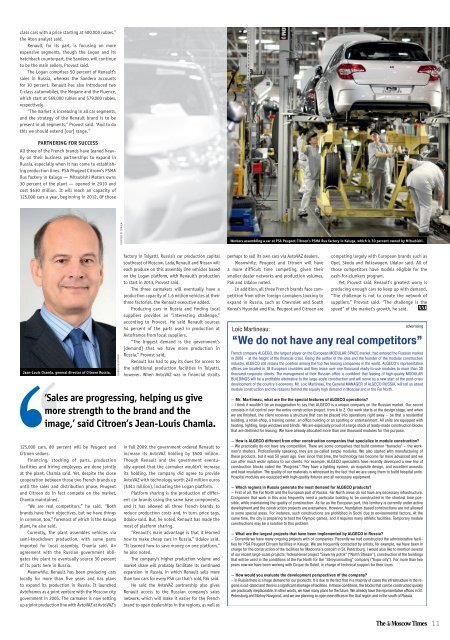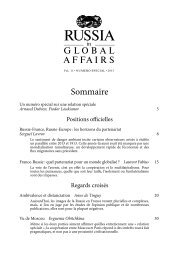said Oleg Dorin of Saint-Gobain. - CCIFR
said Oleg Dorin of Saint-Gobain. - CCIFR
said Oleg Dorin of Saint-Gobain. - CCIFR
- TAGS
- oleg
- dorin
- ccifr
- www.ccifr.ru
You also want an ePaper? Increase the reach of your titles
YUMPU automatically turns print PDFs into web optimized ePapers that Google loves.
class cars with a price starting at 500,000 rubles,”<br />
the Aton analyst <strong>said</strong>.<br />
Renault, for its part, is focusing on more<br />
expensive segments, though the Logan and its<br />
hatchback counterpart, the Sandero, will continue<br />
to be the main sellers, Provost <strong>said</strong>.<br />
The Logan comprises 50 percent <strong>of</strong> Renault’s<br />
sales in Russia, whereas the Sandero accounts<br />
for 30 percent. Renault has also introduced two<br />
C-class automobiles, the Megane and the Fluence,<br />
which start at 569,000 rubles and 579,000 rubles,<br />
respectively.<br />
“The market is increasing in all car segments,<br />
and the strategy <strong>of</strong> the Renault brand is to be<br />
present in all segments,” Provost <strong>said</strong>. “And to do<br />
this we should extend [our] range.”<br />
PARTNERING FOR SUCCESS<br />
All three <strong>of</strong> the French brands have leaned heavily<br />
on their business partnerships to expand in<br />
Russia, especially when it has come to establishing<br />
production lines. PSA Peugeot Citroen’s PSMA<br />
Rus factory in Kaluga — Mitsubishi Motors owns<br />
30 percent <strong>of</strong> the plant — opened in 2010 and<br />
cost $630 million. It will reach an capacity <strong>of</strong><br />
125,000 cars a year, beginning in 2012. Of those<br />
Jean-Louis Chamla, general director <strong>of</strong> Citroen Russia.<br />
125,000 cars, 80 percent will be Peugeot and<br />
Citroen sedans.<br />
Financing, stocking <strong>of</strong> parts, production<br />
facilities and hiring employees are done jointly<br />
at the plant, Chamla <strong>said</strong>. Yet, despite the close<br />
cooperation between those two French brands up<br />
until the sales and distribution phase, Peugeot<br />
and Citroen do in fact compete on the market,<br />
Chamla maintained.<br />
“We are real competitors,” he <strong>said</strong>. “Both<br />
brands have their objectives, but we have things<br />
in common, too,” foremost <strong>of</strong> which is the Kaluga<br />
plant, he also <strong>said</strong>.<br />
Currently, the plant assembles vehicles via<br />
semi-knockdown production, with some parts<br />
imported for local assembly, Chamla <strong>said</strong>. An<br />
agreement with the Russian government obligates<br />
the plant to eventually source 30 percent<br />
<strong>of</strong> its parts here in Russia.<br />
Meanwhile, Renault has been producing cars<br />
locally for more than five years and has plans<br />
to expand its production in Russia. It launched<br />
Avt<strong>of</strong>ramos as a joint venture with the Moscow city<br />
government in 2005. The carmaker is now setting<br />
up a joint production line with AvtoVAZ at AvtoVAZ’s<br />
COURTESY OF CITROEN<br />
COURTESY OF CITROEN<br />
factory in Tolyatti, Russia’s car production capital<br />
southeast <strong>of</strong> Moscow. Lada, Renault and Nissan will<br />
each produce on this assembly line vehicles based<br />
on the Logan platform, with Renault’s production<br />
to start in 2013, Provost <strong>said</strong>.<br />
The three carmakers will eventually have a<br />
production capacity <strong>of</strong> 1.6 million vehicles at their<br />
three factories, the Renault executive added.<br />
Producing cars in Russia and finding local<br />
suppliers provides an “interesting challenge,”<br />
according to Provost. He <strong>said</strong> Renault sources<br />
54 percent <strong>of</strong> the parts used in production at<br />
Avt<strong>of</strong>ramos from local suppliers.<br />
“The biggest demand is the government’s<br />
[demand] that we have more production in<br />
Russia,” Provost <strong>said</strong>.<br />
Renault has had to pay its dues for access to<br />
the additional production facilities in Tolyatti,<br />
however. When AvtoVAZ was in financial straits<br />
‘Sales are progressing, helping us give<br />
more strength to the brand and the<br />
image,’ <strong>said</strong> Citroen’s Jean-Louis Chamla.<br />
in fall 2009, the government ordered Renault to<br />
increase its AvtoVAZ holding by $500 million.<br />
Though Renault and the government eventually<br />
agreed that the carmaker wouldn’t increase<br />
its holding, the company did agree to provide<br />
AvtoVAZ with technology worth 240 million euros<br />
($341 million), including the Logan platform.<br />
Platform sharing is the production <strong>of</strong> different<br />
car brands using the same base components,<br />
and it has allowed all three French brands to<br />
reduce production costs and, in turn, price tags,<br />
Udalov <strong>said</strong>. But, he noted, Renault has made the<br />
most <strong>of</strong> platform sharing.<br />
“Renault’s main advantage is that it learned<br />
how to make cheap cars in Russia,” Udalov <strong>said</strong>.<br />
“It learned how to save money on one platform,”<br />
he also noted.<br />
The company’s higher production volume and<br />
market share will probably facilitate its continued<br />
expansion in Russia, in which Renault sells more<br />
than two cars for every PSA car that’s sold, Pak <strong>said</strong>.<br />
He <strong>said</strong> the AvtoVAZ partnership also gives<br />
Renault access to the Russian company’s sales<br />
network, which will make it easier for the French<br />
brand to open dealerships in the regions, as well as<br />
Workers assembling a car at PSA Peugeot Citroen's PSMA Rus factory in Kaluga, which is 30 percent owned by Mitsubishi.<br />
perhaps to sell its own cars via AvtoVAZ dealers.<br />
Meanwhile, Peugeot and Citroen will have<br />
a more difficult time competing, given their<br />
smaller dealer networks and production volumes,<br />
Pak and Udalov noted.<br />
In addition, all three French brands face competition<br />
from other foreign carmakers looking to<br />
expand in Russia, such as Chevrolet and South<br />
Korea’s Hyundai and Kia. Peugeot and Citroen are<br />
competing largely with European brands such as<br />
Opel, Skoda and Volkswagen, Udalov <strong>said</strong>. All <strong>of</strong><br />
those competitors have models eligible for the<br />
cash-for-clunkers program.<br />
Yet, Provost <strong>said</strong>, Renault’s greatest worry is<br />
producing enough cars to keep up with demand.<br />
“The challenge is not to create the network <strong>of</strong><br />
suppliers,” Provost <strong>said</strong>. “The challenge is the<br />
speed” <strong>of</strong> the market’s growth, he <strong>said</strong>.<br />
11




